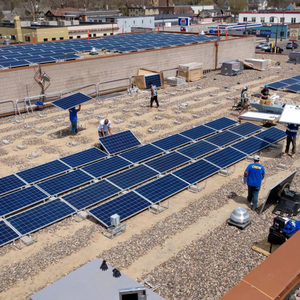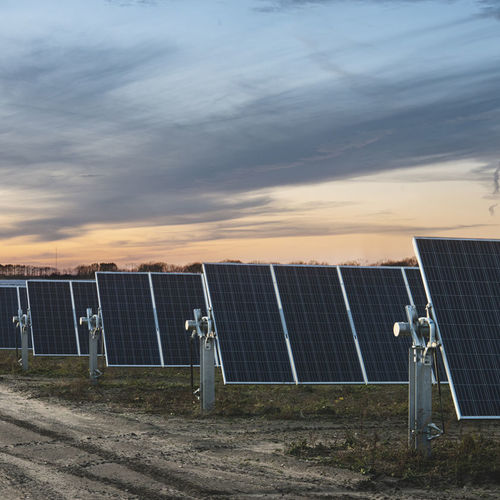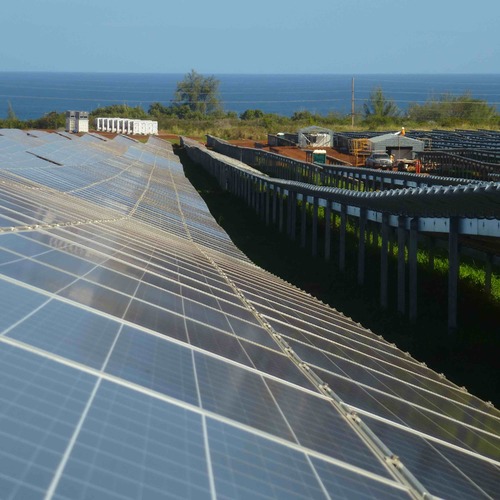
Image Credit: Zach Pippin via Flickr
Recent reports that solar capacity will soon exceed nuclear capacity reveal an important fact. It also hides a crucial distinction needed to understand the context of energy production, and the use and consequences of choices among supply options for the future.
As executive director of the Waterloo Institute for Sustainable Energy (WISE) and lead author of the Equinox Blueprint Energy 2030, a technological roadmap for a low-carbon electrified future, I have investigated energy options, alternatives and their utility. I have also found that people get confused with terminology.
Capacity installed in kilowatts (kW) is not equal to energy produced in kilowatt hours (kWh) — and the energy services we demand and pay for (such as cooking, cooling, lighting, entertainment) is measured in kilowatt hours. For large-scale, industrial purposes, output is measured in megawatt hours (MWh) or gigawatt hours (GWh).
The technical capacity of any energy technology to deliver useful energy is measured as energy output. Because of the efficiency of energy conversion, solar energy output tends to be low.
For example, the energy produced from a large number of solar arrays combined as 1,000 megawatts (MW) installed capacity will deliver, on average, an energy equivalent of 10% to 12% of its capacity. In contrast, a nuclear plant delivers energy at 80% to 90% of its rated capacity.
The current global installed capacity of solar facilities is 224,684 MW, providing an annual energy output of 253,593 GWh, equivalent to an annual capacity factor of 11%. Similarly, the installed capacity of solar facilities in Germany is 39,784 MW, with an annual energy output of 36,056 GWh at a capacity factor of 10.3%.
So, for the same installed capacity, solar energy production is one-eighth or one-ninth of the production of a nuclear plant. If you want the same amount of energy, then you would need to install an equivalent solar capacity that is higher by as large a margin — eight to nine times the number of additional solar arrays.
Less hype, more fact
The point here is not to diminish the value and positive contribution that solar can make towards reducing our dependence on fossil fuels to help achieve a global energy transition towards a low carbon energy future.
The hype needs to be tempered by a realistic assessment of the emerging energy demand at the global level and the effective capability of meeting growth in energy demand on a very large scale.
You don’t want to get conscripted to the view that one energy option — solar — is the sole answer, and it also happens to be an option that does not deliver large volumes of energy from the installed base.
Why is this relevant? The urgency for implementing effective low-carbon energy solutions is all but fully acknowledged and recognized by all the countries of the world (except the current U.S. administration).
Future of energy is diverse and distributed
The scope and scale of change required to meet climate change targets is anything but trivial. This suggests a complementary and reinforcing role for many different energy technologies with low-carbon attributes such as wind, solar, hydro, geothermal, nuclear and natural gas as an interim substitute for coal.
The approach is complementary because each technology has characteristics that require attention to its limitations and to ensure it can function as part of an integrated energy system that delivers best value to the end user.
The emerging energy system of this century will not look anything like the energy system of the past century dominated by central power-generating stations transmitting energy over long distances to cities, towns and villages.
Distributed energy resources — best exemplified by solar as Exhibit A — combined with the power of information and communication technologies (ICT) will increasingly become relevant in our lives.
Imagine a household becomes both an energy generator (solar on the roof) with an electric vehicle capable of storing energy (from wind and solar) and selling the energy back to the wires when it is profitable to do so. All of this could be managed seamlessly through a virtual power network enabled by ICT. Thus, a consumer has now become a producer and a consumer — a “prosumer.”
Technology entrepreneur Elon Musk’s company, Tesla, Inc., is working to make that vision a reality today with its electric cars, solar-cell roof tiles, home energy storage, and networked, grid-connected battery systems currently being installed in Australia.
Decentralized power generation
Will distributed energy become truly disruptive and completely undermine both the business model of the existing utilities and the investments in the large centralized infrastructure?
In my view, distributed energy resources can be best recognized as a positive force that will help reinforce and increase the reliability and resilience of the “big grid.” They also bring an environmental emissions attribute that helps to amplify a positive trend towards a low carbon energy future.
Why do we need large, centralized generating stations at all? The global energy demand to 2050 will either double or triple from current levels. This is primarily driven by demographics and income shifts.
The world’s population is forecast to approach nine billion people in 2050 — with many to shift in income from extreme poverty to low- and middle income levels — which means an inexorable upward pressure on need for energy. A warming climate is another driver of growth in energy demand for cooling.
Improved economic well-being combined with an irreversible shift towards intense urbanization creates a scenario that is difficult to deflect: We are faced with an emerging global context that is shaped by a critical dependence on high quality energy services to a growing, richer population that faces more thermal stress than ever before.
The amounts of energy we need are large, not necessarily because we are energy hogs, but rather that we desire an improved quality of life. This will require a major fine-tuning of the existing energy system that can exploit the best features of all available energy sources in unison.
Jatin Nathwani is professor and Ontario Research Chair in Public Policy for Sustainable Energy at the University of Waterloo. This post originally appeared at The Conversation.
Weekly Newsletter
Get building science and energy efficiency advice, plus special offers, in your inbox.















10 Comments
Perhaps one day people will have their own portable
"suitcase nuke" (self-regulating reactor) which they use to power their dwelling. Now that would give a whole new meaning to the concept of freedom. We can only dream.
Reactor spent fuel
The saddest part of the nuclear power issue is that most of the objections are about the spent fuel, long-term containment and inherent reactor dangers. But there are viable reactor alternatives that produce far less waste, with a much shorter storage period and are inherently much safer to operate. However due to regulatory issues and international agreements they are not used.
Suitcase nukes are useless @ John Clark
The minimum range of output of nuclear power is still pretty high, and the ramp rates limited, whereas the maximum load of a house relative to it's minimum is very high. The relative inflexibility of the dispatch of nuclear reactors make them truly lousy sole-source solutions, every bit as bad (or possibly worse than) solar power as a sole source of power. For those without access to the grid solar is scalable to a micro-level and can provide very valuable service and an upgrade in lifestyle even without the full services a grid could provide, and it's cheap enough now that it would be a crime to argue that those people should wait.
The notion that anyone has proposed or believes hat PV would ever be a sole-source energy or grid solution (seemingly a premise of this blog piece) is simply ridiculous.
"You don’t want to get conscripted to the view that one energy option — solar — is the sole answer..."
Yeah, right- name ONE energy analyst who is pushing that, or trying to "...conscript..." anyone into believing it! (Seriously!?!)
However, even at a 11% capacity factor for PV and 90% capacity factor for nuclear(the US average, which is higher than the world average), PV's annual net output will meet or exceed that of nuclear in about 3 doublings. The installed base of PV is doubling roughly every two years (and the doubling rate is increasing), and nuclear power is not expanding, so it's really going to be no more than five years before PV is putting more power onto the grids worldwide than nuclear power.
But so what?
Why compare it to nuclear power, given the high cost and difficulty of building out new nuclear and the low cost and scalability and ease of installing PV? It takes only about 6 doublings of PV capacity for it to be producing as much annual power as all current grid generators. That doesn't mean solar will be providing 100% of the power in (2 years per doubling x 6=) 12 years, but it DOES mean that it will be providing a truly MASSIVE amount of power in 2030 compared to today, and it'll be DIRT CHEAP!
At utility scale it became the cheapest new form of power of any type in late 2016 and credible analysts are now projecting the levelized cost of new utility scale PV to be at or under 1 US cent per kwh by 2025. Recent auctions in multiple countries are already coming in under 2 cents/kwh for projects coming on line prior to 2020, well under the maintenance or fuel cost of any fossil burner or nuke. With costs that low new business models are going to have to be built to keep anything else going. Wind power is comparably cheap now, but won't get cheaper as fast as PV is projected to be, but is also cheaper than the maintenance & fuel costs of traditional power. In the US (outside of the west coast) wind has a good seasonal complement characteristic, peaking in winter as PV is flagging, and at it's nadir during the summer season when PV output is still high. It's not perfect, but the grid mix that's the cheapest operationally will have both PV and wind in high quantity.
Let's be honest, do the numbers, and let the best win.
Capacity factor?
>Over the lifetime of a PV panel, it produces about the same amt of power per square meter coal strip mine, so is quite comparable in power production in some lights. (I heard this quoted, doubted it, but the numbers add up)
>your 80% to 90% power factor hides the fact that power demand is variable. Current nuclear power plants can not be varied much, while power not required from a PV farm can be curtailed.
Lots more, but the fact is that this stuff is COMPLICATED and simply paying homage to nuclear.... or wind, coal, or pv.... won't work. It reminds me of the publications saying X (honey, dates, whatever) is the perfect food, ignoring rather essential facts.
That said, given newer types of nuclear that can be ramped better (if they can be cheap enough) and storage to deal with variations in demand and production, it could be very useful.... but pv is already producing under contracts at $0.03/kw.hr in some places and, with storage, could be the winner. We may only need advanced nuclear plants to burn off the huge stockpiles of nuclear waste, still containing most of the original energy content, we currently have on hand.
Capcity factor.
The Capacity factor of new utility pv in the southwest U.S. is 30%. Trackers are used in 78% of new build. The lowest capacity factor is 18.8% in the NorthEast U.S.
Aside from Capacity Factor being an outdated parameter to use, a complete study on this whole issue has been published by Stanford Professor Mark Z. Jacobson. Stanford engineering ranks in the top 3 in the world. This study took years to produce and does not use nuclear as a source.
What constitutes "...the best..." isn't a single number @ Skip
Levelized cost is only one attribute- an important attribute to be sure, but not an ALL IMPORTANT attribute for running a grid cost effectively. Dispatchable load is cheaper than dispatchable power and after FERC ORDER 745 was blessed by the Supremes those markets will be developed, but there is quite a bit of rule-making and regulation adjustment to be done to make electricity markets function well in the face of the cheap PV tsunami. There are a lot of smart people working the problem but there are lots of moving parts, with lots of stakeholders and oxen to be gored.
A tip-of the iceberg overview of the evolving electricity market re-design is covered in this recent Greentech Media podcast:
https://www.greentechmedia.com/articles/read/liberals-and-progressives-unite-over-electricity-market-design#gs.sbLBvHo
"That said, given newer types of nuclear that can be ramped better..."
Even the small modular reactors (SMR) that are looking good on paper aren't nearly flexible enough to track the load of a house. With some amount of additional storage MAYBE they can track the load of 5000 person village.
The earliest proof-of-concept builds for SMRs that meet US standards are (perhaps optimistically) projected to happen in the mid 2020s, and the costs/levelized-costs are still TBD. But at the learning curve of PV, wind, and batteries it's going to be a much more competitive electricity market for the technology be born into than present day markets. Terrestrial Energy is CLAIMING they will be cheaper than natural gas, but is that even good enough? Who cares about the price of gas-fired electricity? By the time the first plant gets built it will have to be at least as cheap as wind and solar (at that time) to be able to make the case.
PV with a levelized cost of 1 cent/kwh (1 cent assuming no curtailment) can curtail half of the output and still compete easily with EXISTING combined cycle natural gas on the gas plant's operational costs alone. For new powerplants utility scale PV in 2017 at 4.5-5 cents/kwh levelized cost is already competitive with NEW combined cycle gas at 4-8 cents/kwh. See Lazard's levelized cost analysis published a few weeks ago:
https://www.lazard.com/media/450337/lazard-levelized-cost-of-energy-version-110.pdf
Wind and solar are already as cheap or cheaper than natural gas, and will be quite a bit cheaper by 2025. So if not cost, what necessary services will the SMRs be bringing to the table, really? The ultra-cheap dispatchable load party is just getting started (and will be enhanced by smart car chargers as the EV fleet builds, fixing much of the problems associated with the large PV build out) , as is the distributed storage. The relative value of dispatchability is likely to be heavily discounted by the time the first SMRs are built.
There may still be a market for some number of them if unique attributes can be defined (and monetized within electricity markets) but I'm guessing SMRs will end up being a niche market, not the backbone of the 21st century grid.
Yes capacity factor number are distorting @ Ven Sonata
Mark Jacobson's numbers and grid models notwithstanding, the 11% capacity factor number cited by Jatin Natwani may have been a true average when foggy-dew northern Europe held a large fraction of the world's installed base of PV, but in most of the world (particularly in the developing world) world capacity factors are going to beat that by quite a bit.
This blog article feels a bit like flogging a straw man (or a dead horse). Most of the world (particularly those in the business of keeping the lights on) have moved on to more interesting aspects of making the transition happen as smoothly as possible, screw-ups like SCANA or Vogtle or Kemper notwithstanding. Most already understand Jatin's point that the future of the grid will be far more distributed, far less centralized, cheaper, greener, and more resilient than the 20th century grid model, and that it is happening much faster than anyone was projecting even a handful of years ago.
Thanks for the detail and perspective, Dana
The information, perspective, and details provided by Dana Dorsett are very valuable to me. Thanks for all that you add to these discussions.
Natural gas
It's true that the Natural Gas Association has been hugely successful touting NG as a "cleaner" or "low-carbon" alternative to coal. Methane, the major constituent in NG it is 85 times as damaging to the atmosphere as carbon. It has been found to leak all along the supply chain. For a detailed discussion, you might read, https://thinkprogress.org/methane-leaks-erase-climate-benefit-of-fracked-gas-countless-studies-find-8b060b2b395d/
Response to Jim Baerg
Jim,
Here is a link to a GBA article on the same topic: Natural Gas Pipelines Are Leaking.
Log in or create an account to post a comment.
Sign up Log in